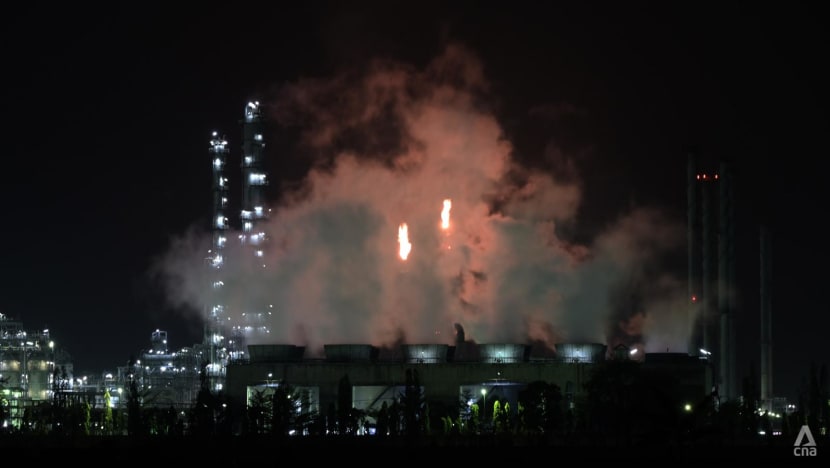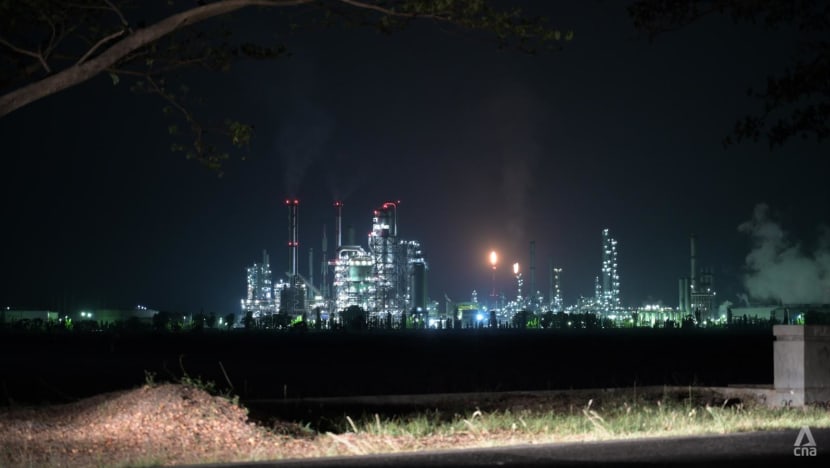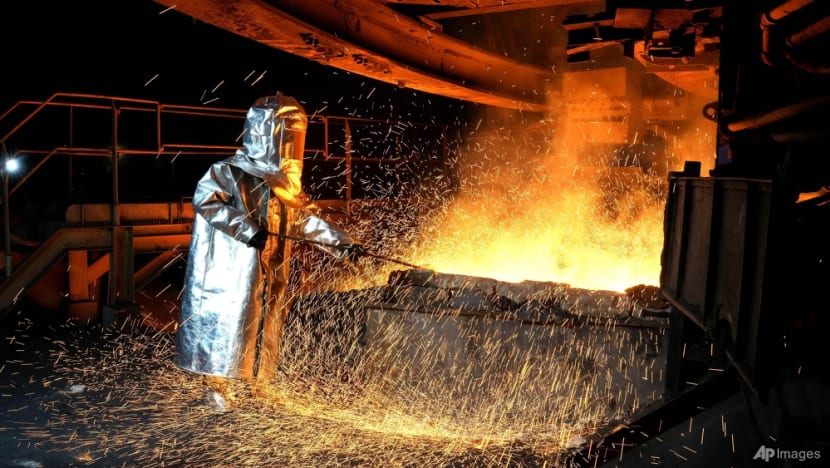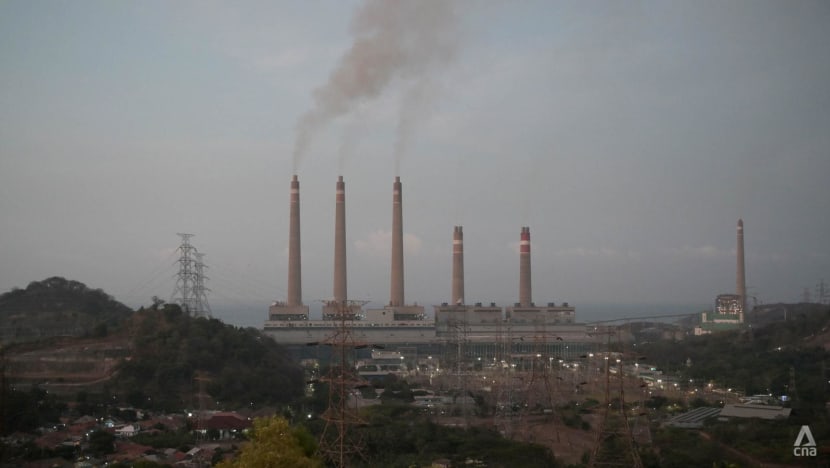Indonesia's ambitions to be a hub to store carbon emissions could be risky business
With a capacity of over 600 billion tonnes, Indonesia is going big on carbon capture and storage. But costs are high and the technology racks up a large energy bill. Will it really help to drive down emissions?


This audio is generated by an AI tool.
SUBANG, Indonesia: Where once a towering oil rig stood in the middle of farmer Sukirman’s rice field, a box-shaped metal cage now sits.
Encasing a jumble of pipes, gauges and valves, it is a reminder of the years between 2018 and 2022, when state-owned oil company Pertamina was drilling hundreds of barrels’ worth a day from underneath his village in Subang regency in West Java.
Back then, nights were as bright as day as incessant flames from the burning of volatile gases – common by-products in oil production – illuminated Mr Sukirman’s neighbourhood on Java’s northern coast.
Last year, everything stopped.
“Workers began dismantling the rig, plugged the well with these pipes and left,” the 51-year-old told CNA. The oil had dried up and the company moved on to other sites in Subang, he said.

But if Indonesia’s plan to become an Asia Pacific carbon capture and storage (CCS) hub becomes reality, the decommissioned oil well may get a second lease on life.
Indonesia is planning to use thousands of these depleted oil and gas reservoirs across the country to permanently store carbon dioxide churned out by heavy industries, including foreign ones.
Its plans have drawn interest from several oil giants, which claim it is a way to reduce emissions and support economic growth.
During President Joko Widodo’s visit to Washington this month to meet his United States counterpart Joe Biden, Pertamina inked agreements with Exxon Mobil and Chevron to carry out further evaluations for US$2 billion in investments for facilities using two underground basins in the Java Sea.
Another oil major, BP, has a carbon capture, utilisation and storage (CCUS) project in Tangguh, off West Papua, that began construction on Nov 24.
Indonesia has also invited countries like Japan, South Korea and Singapore to develop infrastructure needed for carbon storage in the country.
Amid the bubbly optimism, however, analysts have sounded caution about CCS’ high cost – between US$80 and US$1,000 per tonne of CO2 stored – and the fact that it uses a lot of energy. CCS projects have a record of underdelivering on emissions reduction targets, with some projects abandoned midway into their construction.
IT BOILS DOWN TO COST
CCS technology dates back to the 1970s and was intended to extract more oil from reservoirs rather than to reduce carbon emissions.
Injecting carbon dioxide into a depleting well can improve the fluidity of crude oil, allowing more of the fossil fuel to be extracted.
Several companies have used the technology to boost their production in Indonesia and officials hope that in a few years, these wells might become commercially available to store carbon from local and foreign sources.
“Before, there was only (one) option for depleted wells, which is to decommission them in a process known in the oil industry as plug and abandonment,” said Dr Belladonna Maulianda, executive director of the government think tank Indonesia Carbon Capture and Storage Centre (ICCSC), which was set up in May.
“Instead of spending capital for plug and abandonment, why not use (the wells) for CCS?”
Studies have suggested Indonesia’s depleted oil and gas reservoirs have the potential to store eight billion tonnes of carbon dioxide.
However, CO2 can also be stored in saline aquifers, which are underground rock formations saturated with salt water. A government think tank, the Oil and Gas Research and Development Centre (Lemigas), estimated that Indonesia’s saline aquifers can store up to 600 billion tonnes of carbon dioxide.

Indonesia is well-placed for CCS, given its vast land area, said Mr Bill Sullivan, a Jakarta-based lawyer specialising in mining and environmental laws.
The “real issue”, he said, is “technology and the cost of using that technology, and whether or not that makes it a viable proposition”.
There are generally two types of CCS. The first type, known as point-source capture, is where fumes emitted from factories and power plants are directly piped into a facility where carbon dioxide is separated from other gases.
The second, known as direct air capture, is where CO2 is directly extracted from the atmosphere and sequestered underground or used in various applications.
Related:
Both processes involve pressurising the captured carbon dioxide into a liquid state for easy transportation.
Some estimates suggest that it can cost between US$80 to US$150 for every tonne of carbon dioxide captured, transported and stored using point-source capture.
Direct air capture is even more expensive, costing between US$600 to US$1,000 per tonne.
There are 41 CCS facilities in operation worldwide with a capture capacity of 49 million tonnes of CO2 per annum, according to the Global CCS Institute. In contrast, global energy-related CO2 emissions exceeded 36.8 billion tonnes last year, according to the International Energy Agency.
The hefty price tag is the reason why critics cast doubt on its effectiveness and why most companies are reluctant to adopt the technology.
Indonesia’s energy sector, for example, emitted 600 million tonnes of CO2 in 2021, which means power plants in the country would have to spend billions of dollars every year to store carbon they emit.
Dr Belladonna said Indonesia plans to create CCS hubs where a number of factories can share the same point-source capture facility.
“The economics will be cheaper because several companies share the same infrastructure, facilities, costs and liabilities,” she said.
There are currently two potential sites for Indonesia’s first CCS hubs, in Java and Borneo, she said. Feasibility studies of the two locations are still being conducted.
VIABLE SOLUTION OR A RED HERRING?
Adopting CCS technology to reduce carbon emissions is a Catch-22, analysts said, since it paradoxically helps oil companies boost their fossil fuel production.
“The fossil fuel industry is trying to buy more time with the help of CCS technology and keep producing oil and gas,” said Mr Leonard Simanjuntak, Indonesia director of environmental group Greenpeace.
Indonesia’s ambition to become a regional CCS centre comes amid declining oil production. The country’s yearly output is now about a third of what it was around three decades ago, and it became a a net importer in the early 2000s.
According to Indonesia’s energy ministry, the country’s oil production peaked at 2.96 million barrels per day in 1994. Production has steadily declined. Last year, Indonesia’s oil output was 1.01 million barrels per day.

Huge amounts of energy are also needed to capture, compress, transport and inject carbon dioxide. The Intergovernmental Panel on Climate Change (IPCC) noted this “energy penalty” can be quite substantial, increasing the fuel needed for electricity generation by 13 to 44 per cent.
“This means more carbon dioxide is being emitted which needs to be stored,” Mr Leonard said.
Critics have also called CCS a red herring, distracting governments and taking investments away from cheaper and more reliable methods of reducing emissions.
“Many are doubting CCS’ effectiveness in reducing carbon emissions,” said Mr Putra Adhiguna of the US-based think tank Institute for Energy Economics and Financial Analysis.
The biggest risk of CCS is that it takes public attention away from more viable options like transitioning from fossil fuels to renewable sources of energy, retiring coal-fired power plants or preventing deforestation.”
Related:
But Dr Belladonna said CCS is the only solution for certain sectors, if Indonesia wants to achieve its target of becoming net-zero by 2060.
“There are sectors which are hard to abate, hard to decarbonise like cement, steel, methanol, fertiliser and petrochemical. Even if they try electrifying their vehicles or switching fuel, they still produce CO2,” she said.
“For these sectors, they need CCS.”

SOURCE OF INVESTMENT, OR ‘GARBAGE’ FROM OVERSEAS?
With CCS seemingly out of reach for the majority of Indonesian companies due to its high costs, experts are questioning whether Indonesia’s plans can truly help the country reach its net-zero emission goal, or serve instead to benefit foreign entities.
The government is working on regulations to allow other countries to bury their carbon in Indonesia.
“We can view it as a possible source of income where Indonesia can gain climate funding from that particular sector, especially from countries which do not have their own forests – they need to find ways to offset the emissions that they produce to another country,” said Mdm Farah Vianda of Jakarta-based think tank Institute for Essential Services Reform (IESR).
The sustainable financing expert said Indonesia needs to limit the amount of carbon storage earmarked for the international market, leaving the rest to cater to domestic needs.
“We shouldn’t sacrifice our own interests just because we need the money,” she said.
Mr Bhima Yudhistira, the executive director of think tank, Centre of Economic and Law Studies (CELIOS) highlighted that there is currently no incentive for local businesses to store their carbon emission.
“We currently don’t have a carbon tax regime,” he pointed out.
Indonesia was supposed to introduce the tax in 2022 but postponed its implementation to 2025, saying it needs time to make sure the scheme would not clash with existing laws and regulations.
Under the proposed scheme, companies must pay 30,000 rupiah (US$1.90) for every tonne beyond an allotted cap, which is considerably lower than the cost of storing carbon.

Dr Belladonna admitted that so far, only foreign countries and multinational companies have expressed interest in storing their carbon in Indonesia.
“We don’t have the infrastructure (to perform CCS) ... and we need money and investment to achieve net-zero emission and to bring new potential revenue for Indonesia,” she said.
“We don’t yet have a carbon tax or incentives to motivate domestic players. The solution is to open (up) to other countries. They have the motivation because they have carbon taxes but they have no storage capacity.”
Over time, she believes local firms will be interested, especially if innovation further drives down the cost of CCS.
“Investors are already taking into consideration whether or not they can do CCS ... because they don’t want to contribute to global emissions. Banks are already requiring companies to submit sustainability reports and emission portfolios before lending their money. Consumers are also becoming more environmentally conscious and demand net-zero products,” said Dr Belladonna.
But the idea of allowing other countries to stow their carbon in Indonesia could be controversial among some patriotic Indonesians, said Mr Bhima.
“(CCS technology) has caused concerns that developed countries will be … throwing their garbage, in the form of carbon, to developing countries like Indonesia,” he told CNA.
“If developed countries are also committed to reducing their emissions, then their policy should not come in the form of CCS but to really reduce the production of their pollutants.”















